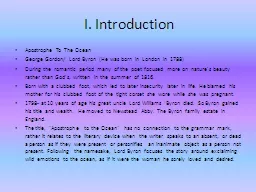PPT-Apostrophe to the Ocean
Author : mitsue-stanley | Published Date : 2016-02-22
By Lord Byron George Gordon Lord Byron Author Biography George Gordon Lord Byron was born in London on January 22 1788 to Mad Jack Byron and Catherine Gordon Born
Presentation Embed Code
Download Presentation
Download Presentation The PPT/PDF document "Apostrophe to the Ocean" is the property of its rightful owner. Permission is granted to download and print the materials on this website for personal, non-commercial use only, and to display it on your personal computer provided you do not modify the materials and that you retain all copyright notices contained in the materials. By downloading content from our website, you accept the terms of this agreement.
Apostrophe to the Ocean: Transcript
Download Rules Of Document
"Apostrophe to the Ocean"The content belongs to its owner. You may download and print it for personal use, without modification, and keep all copyright notices. By downloading, you agree to these terms.
Related Documents














